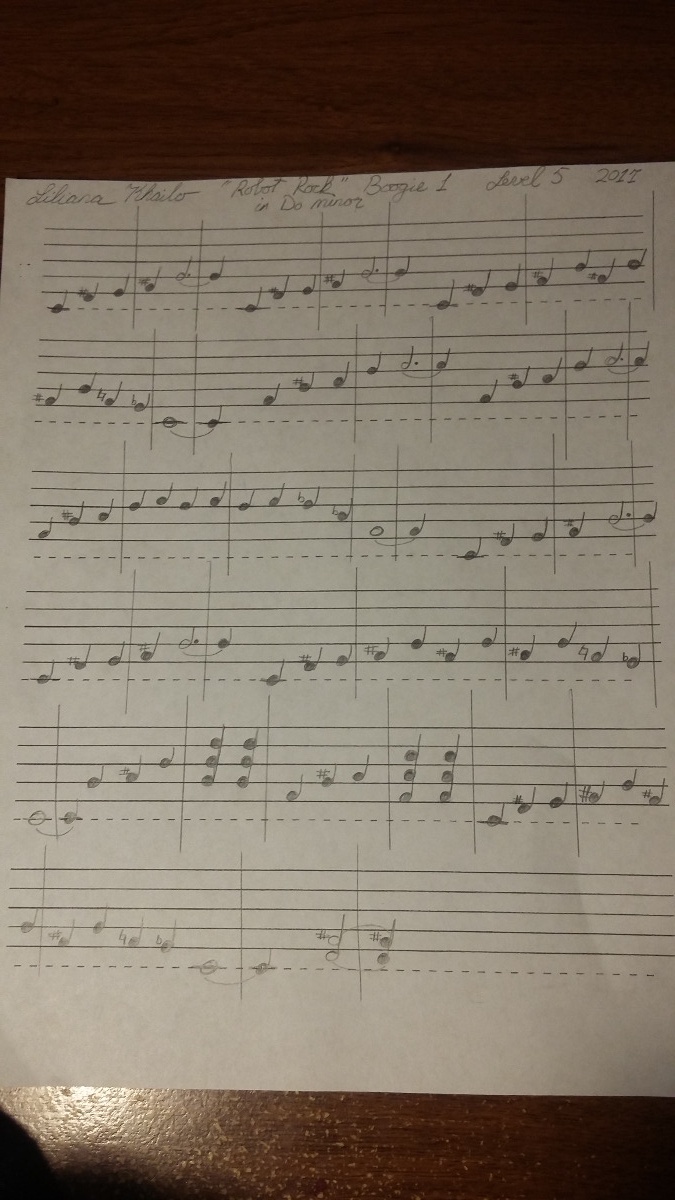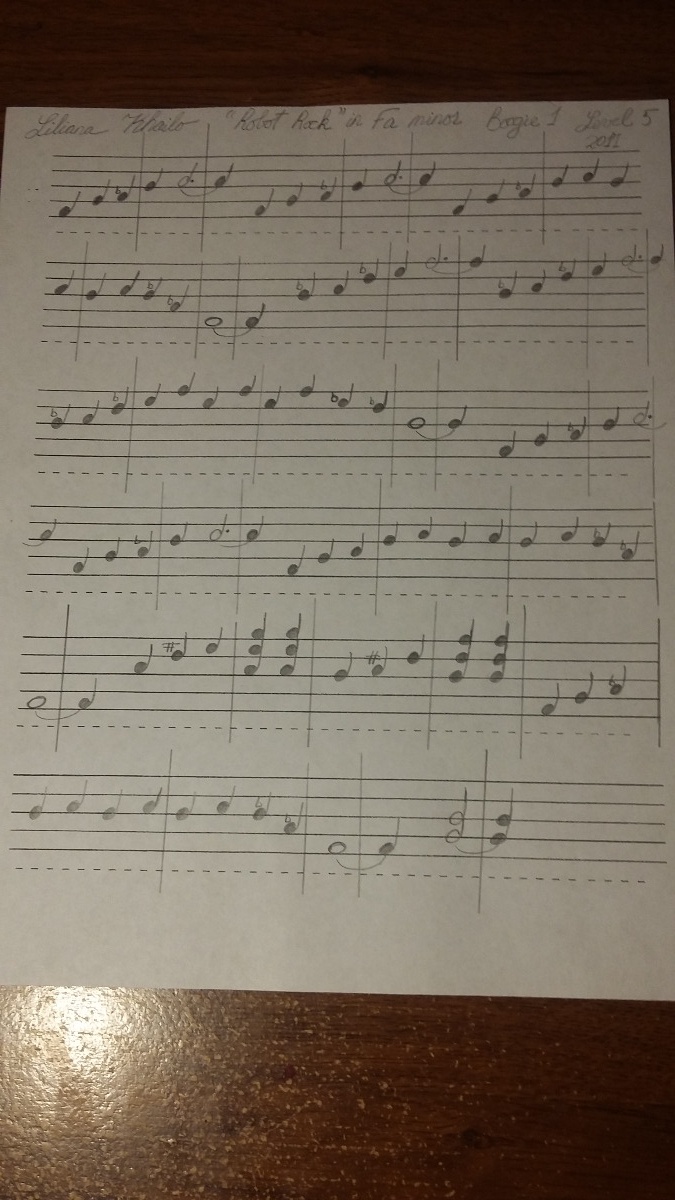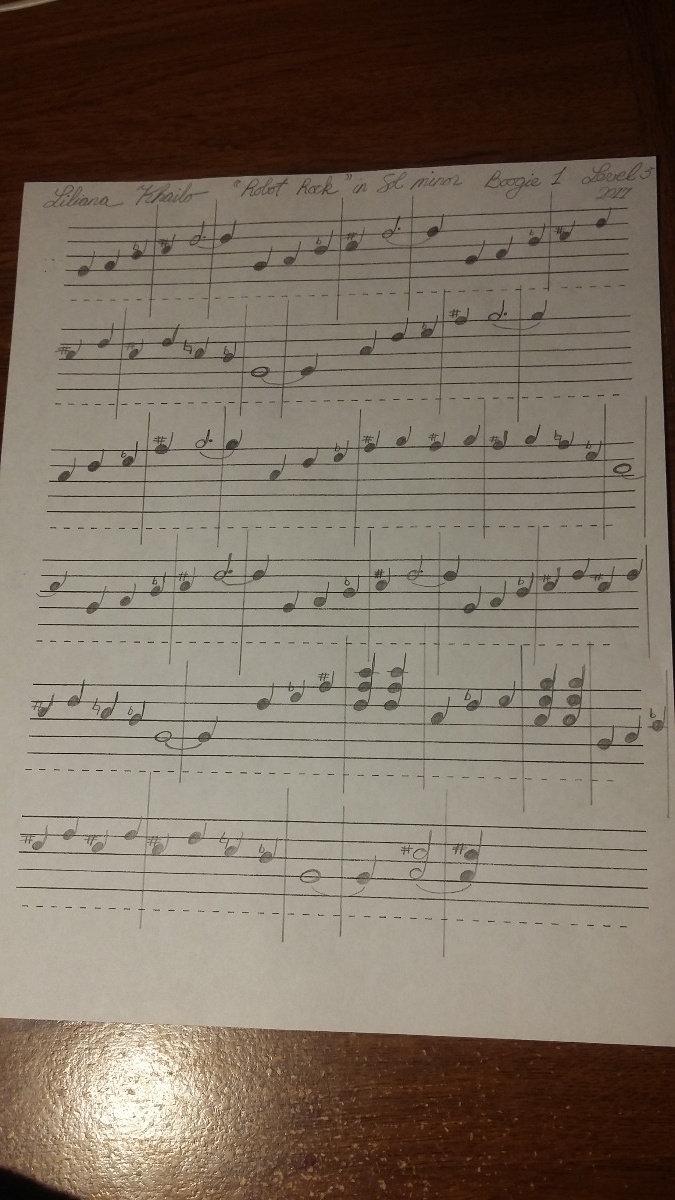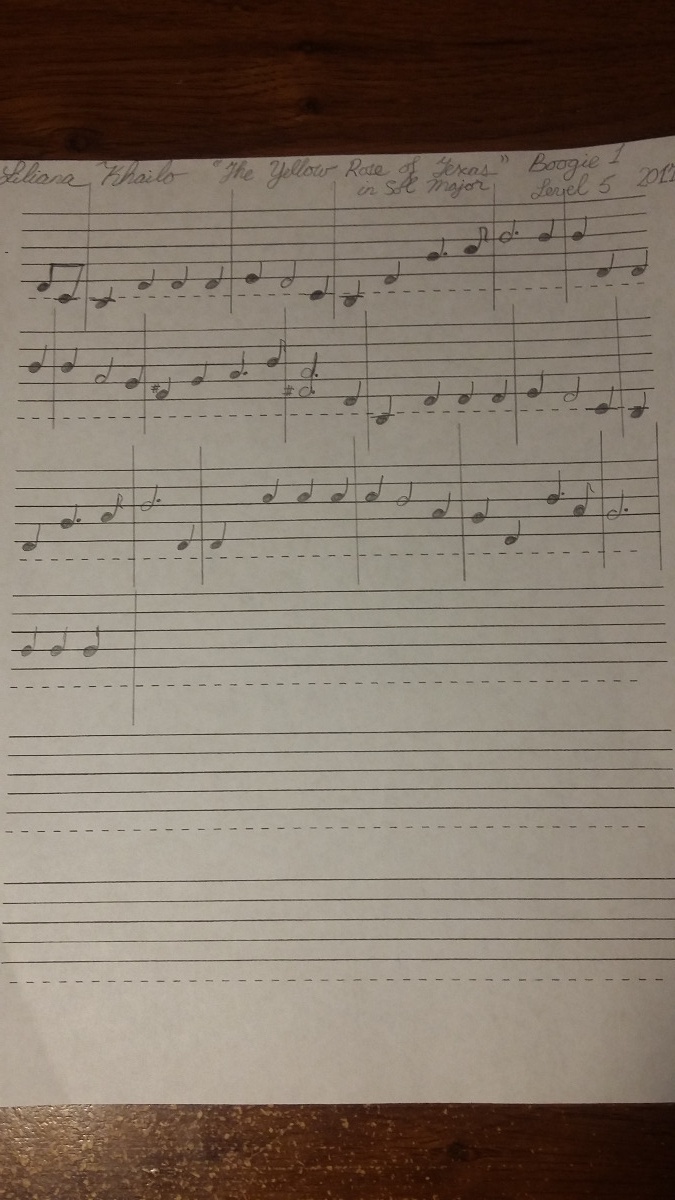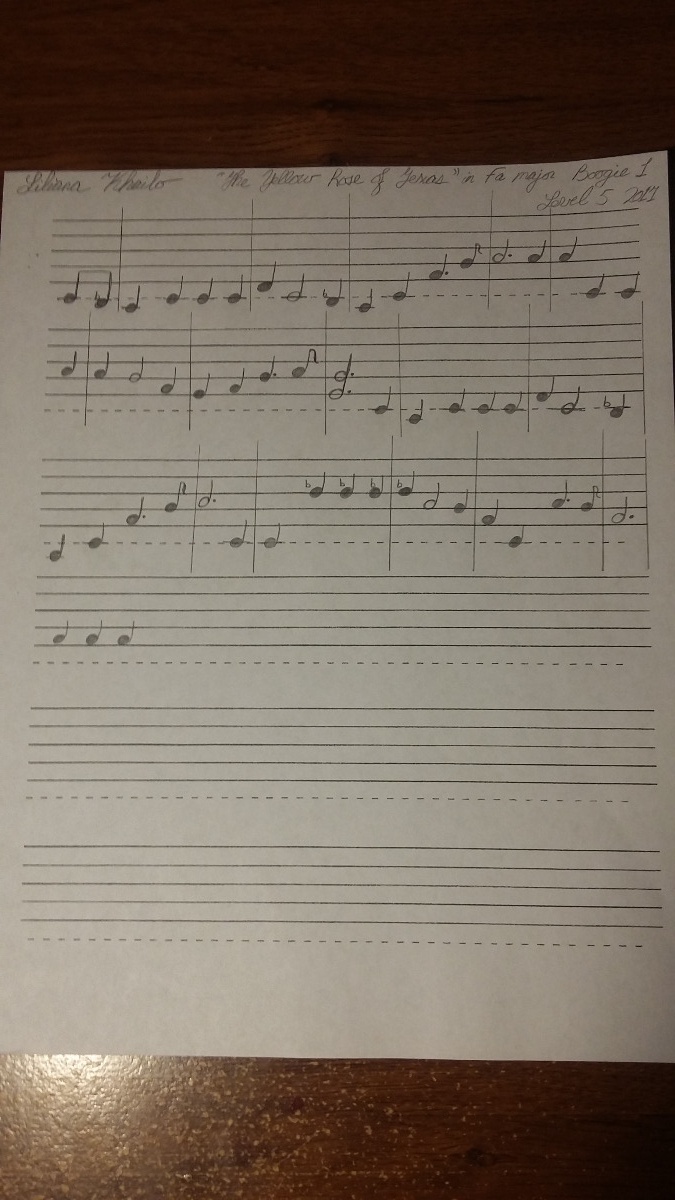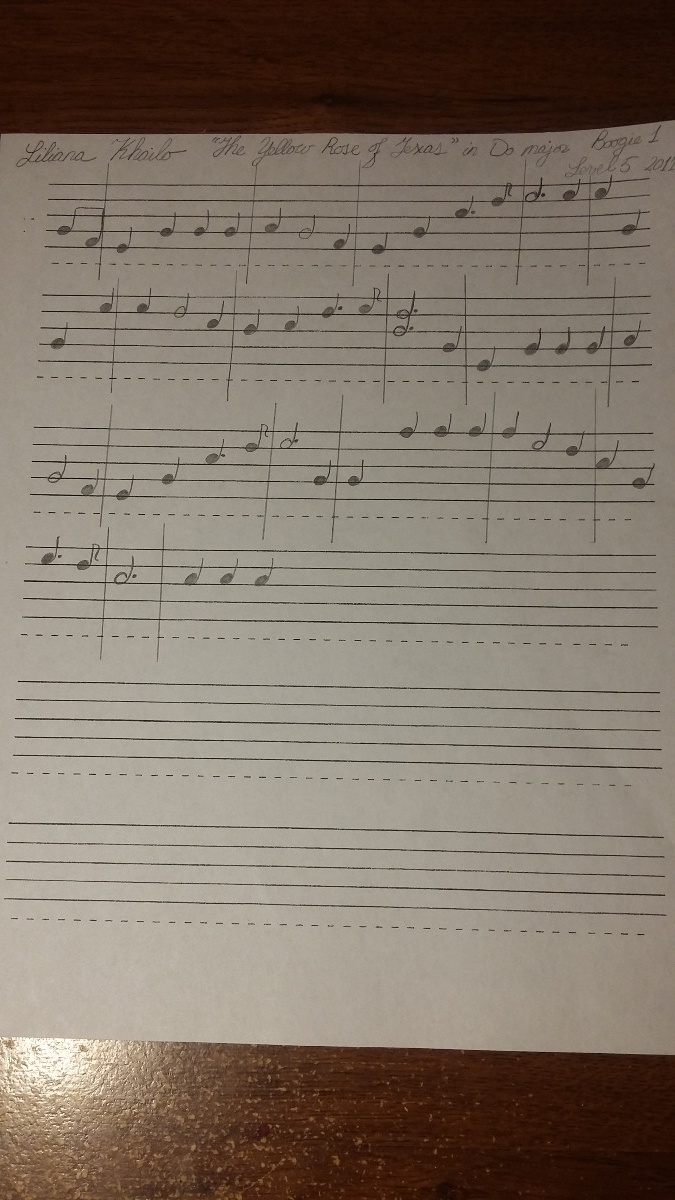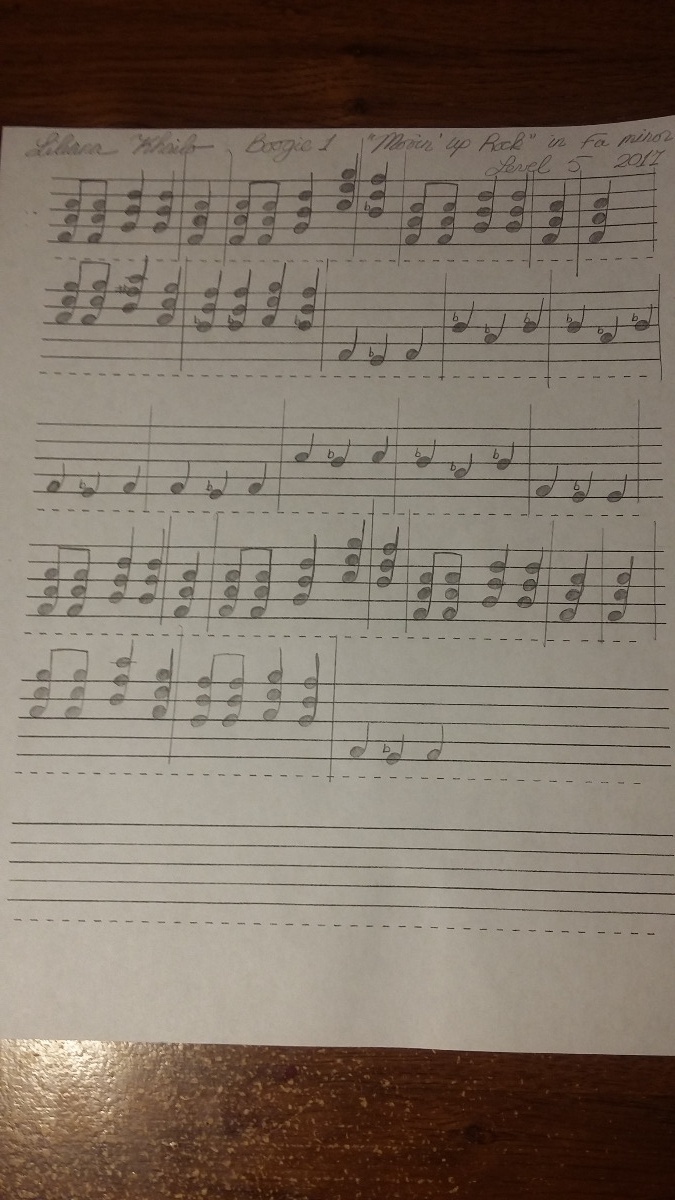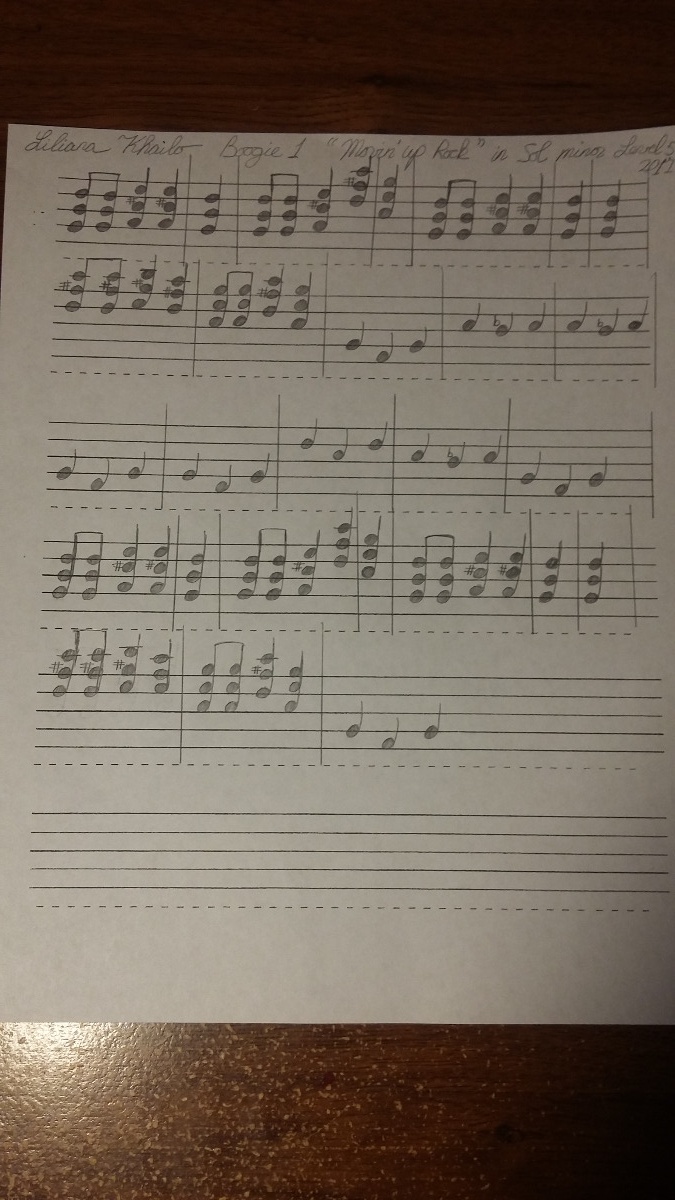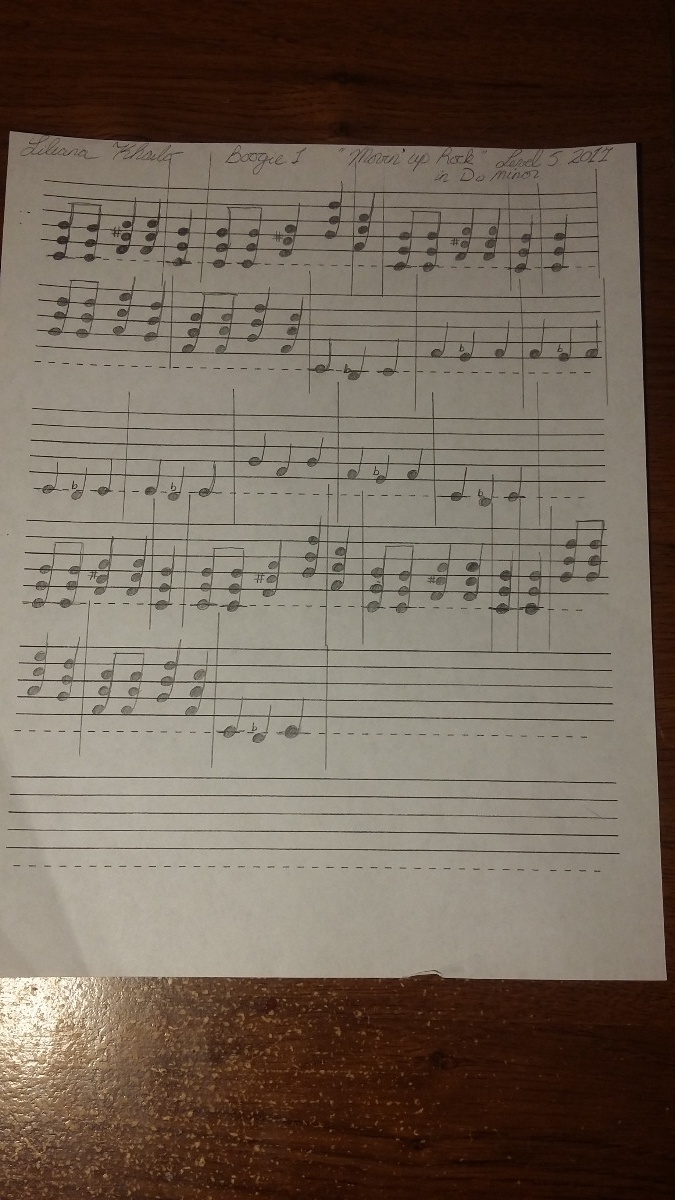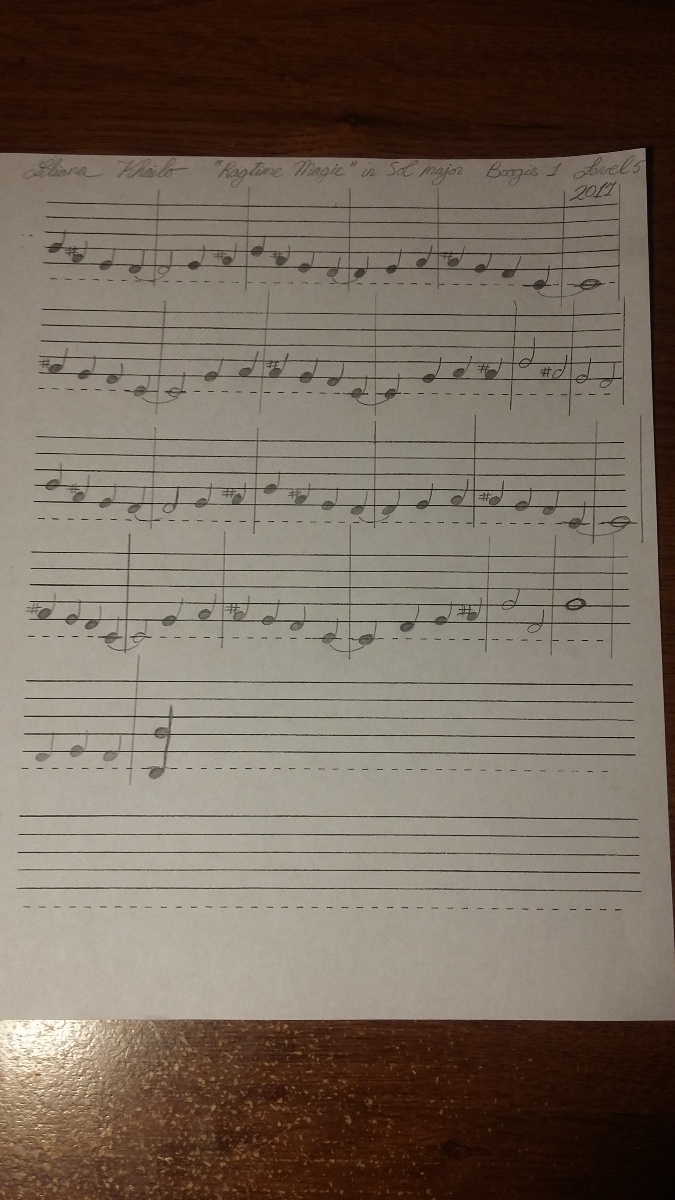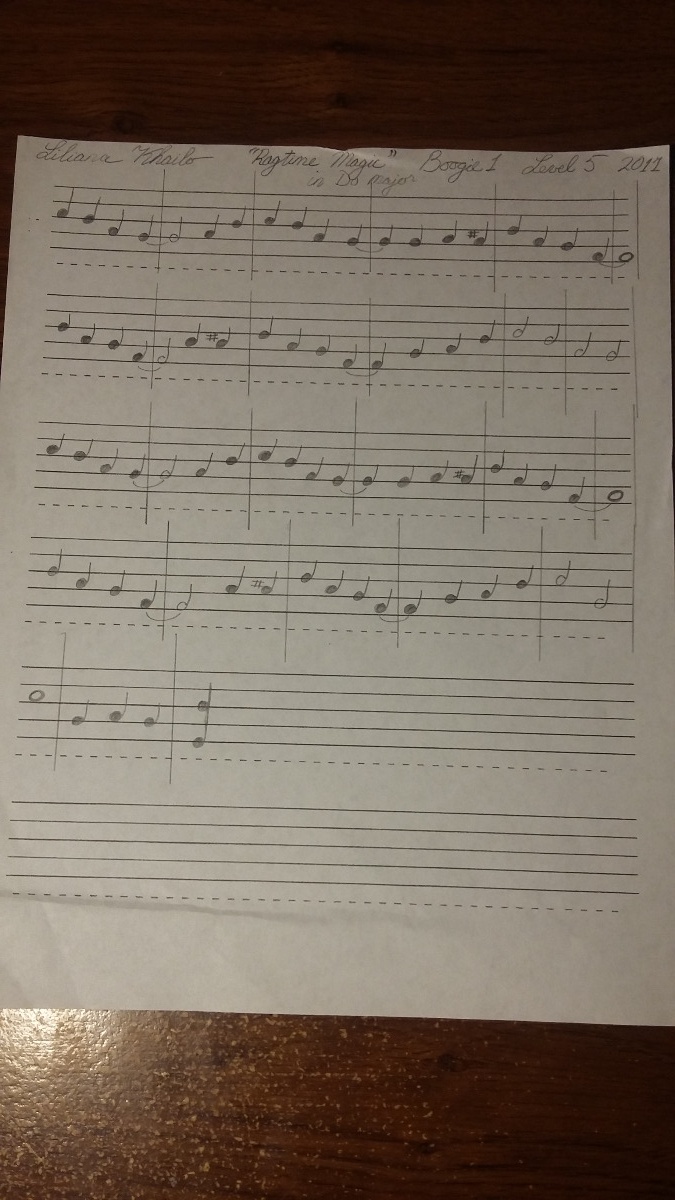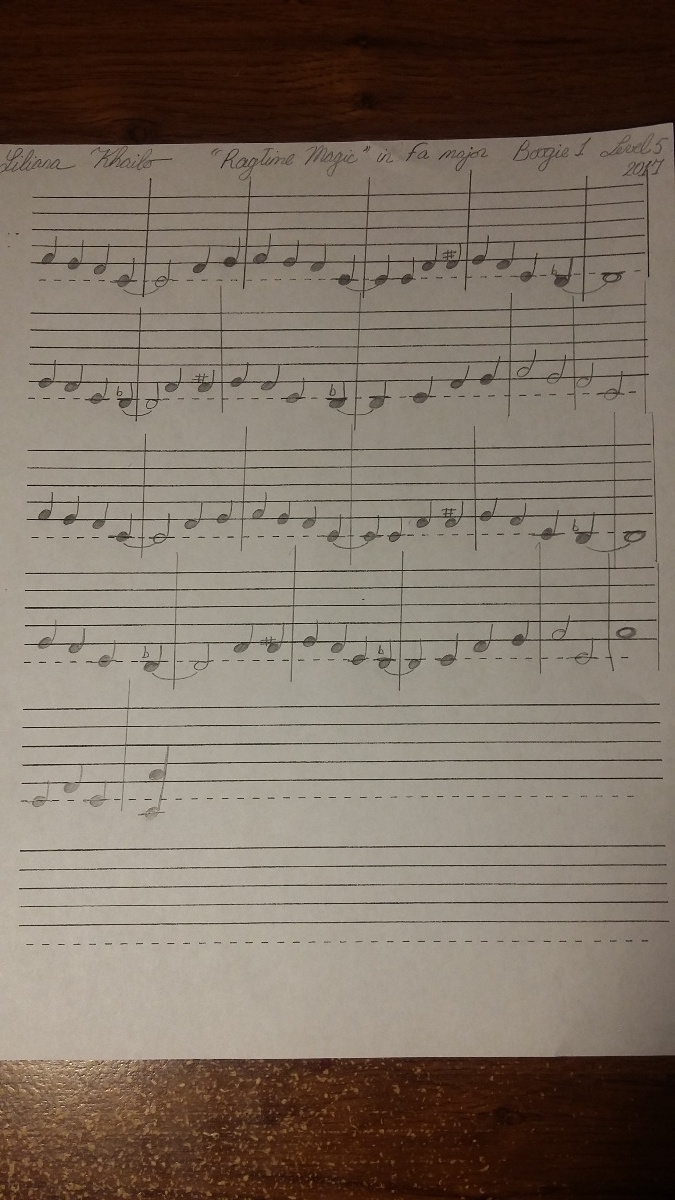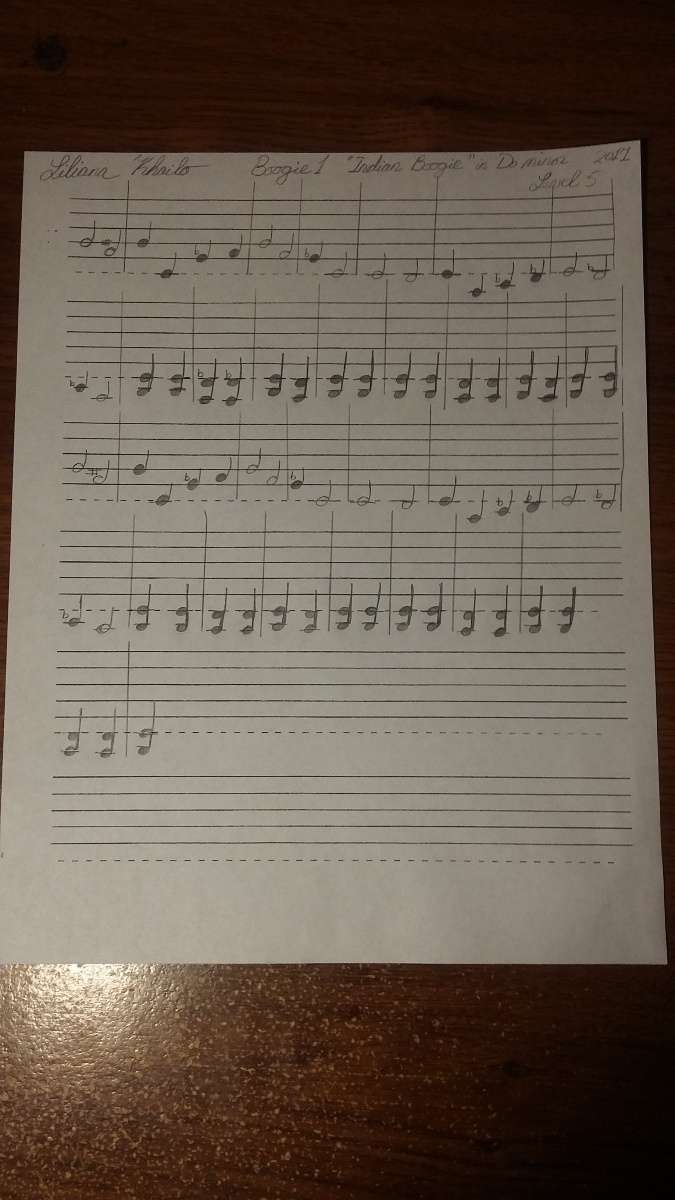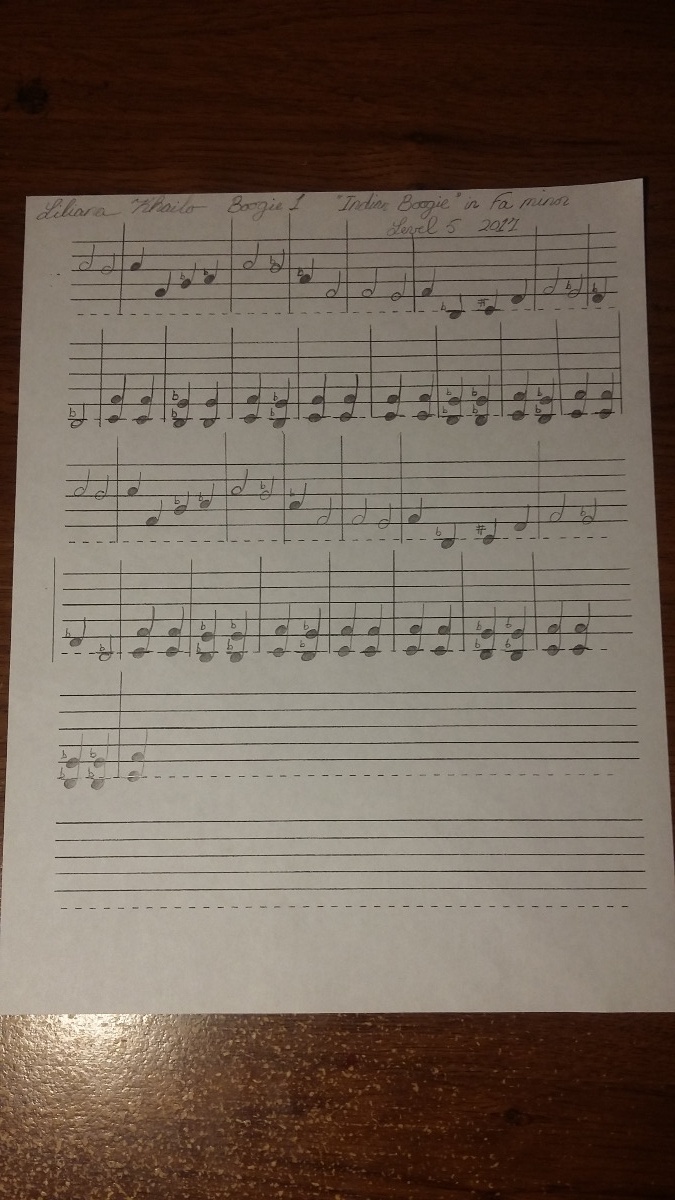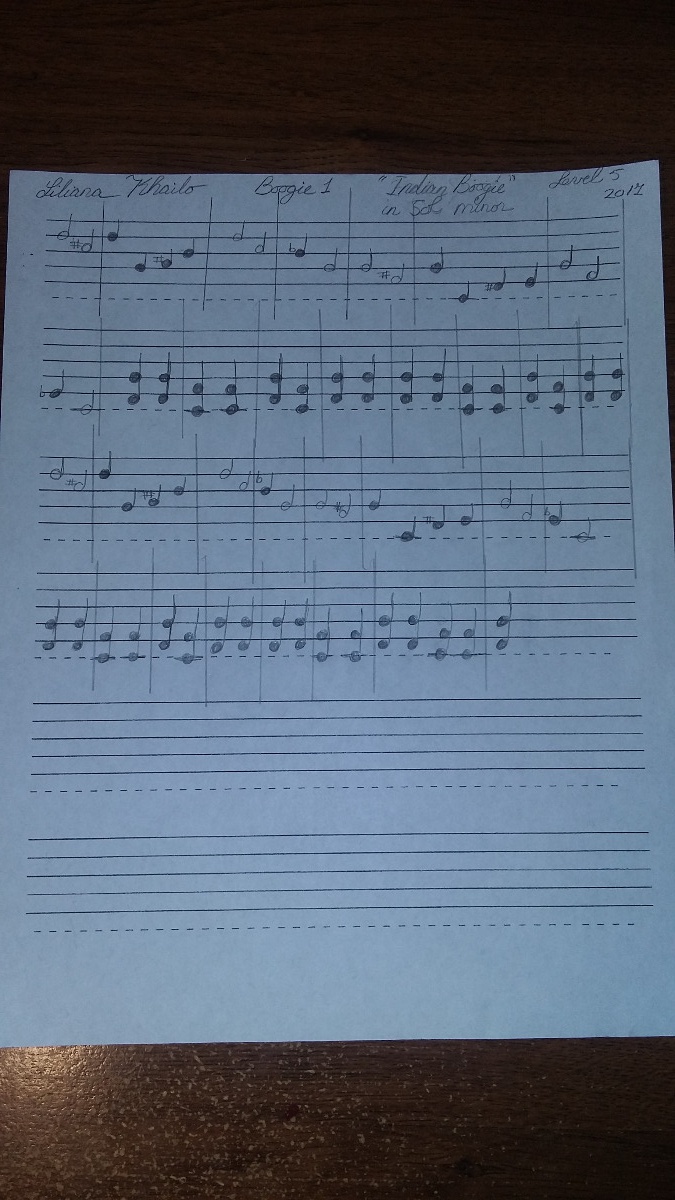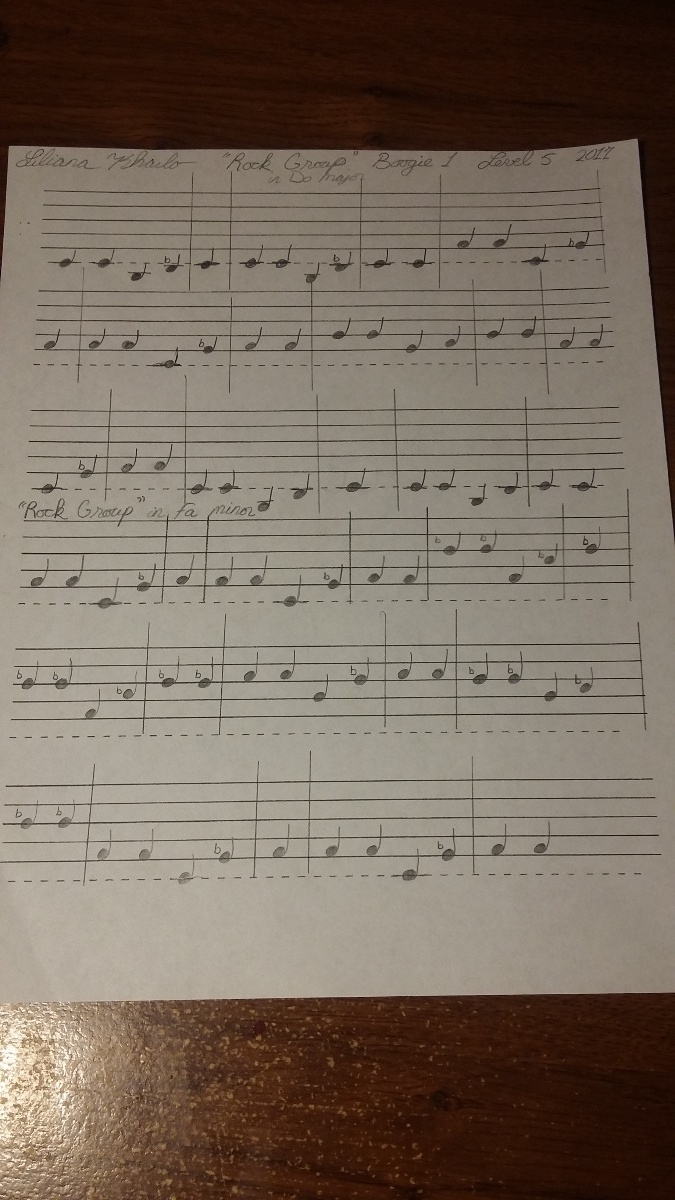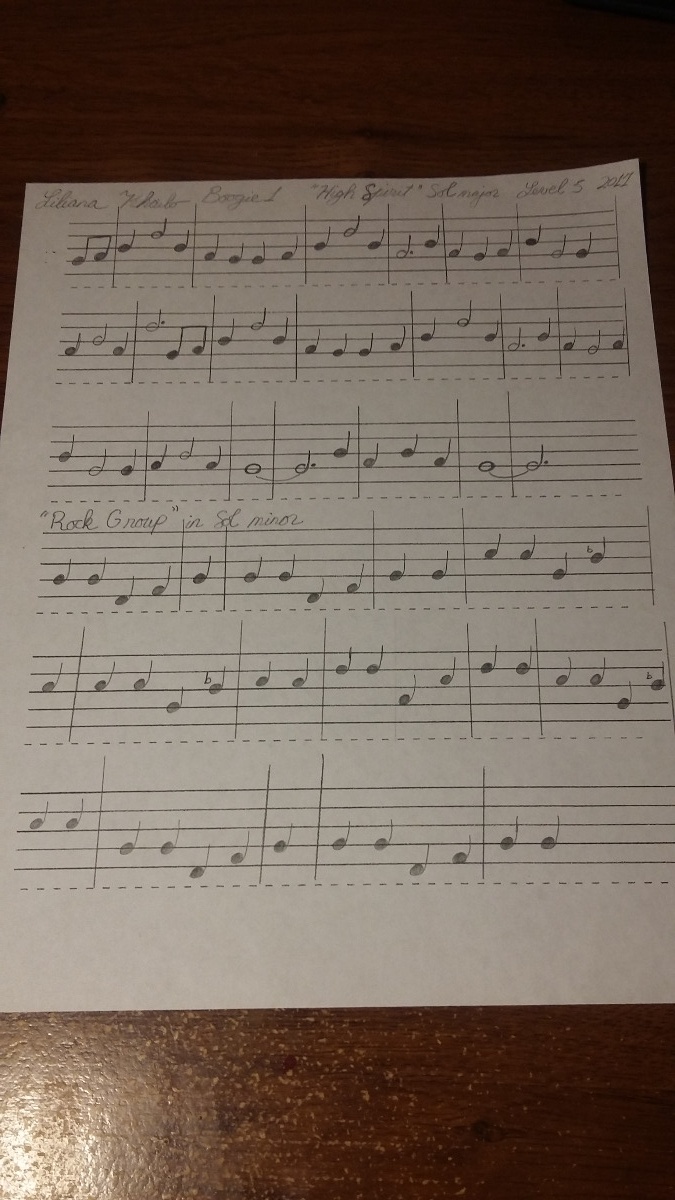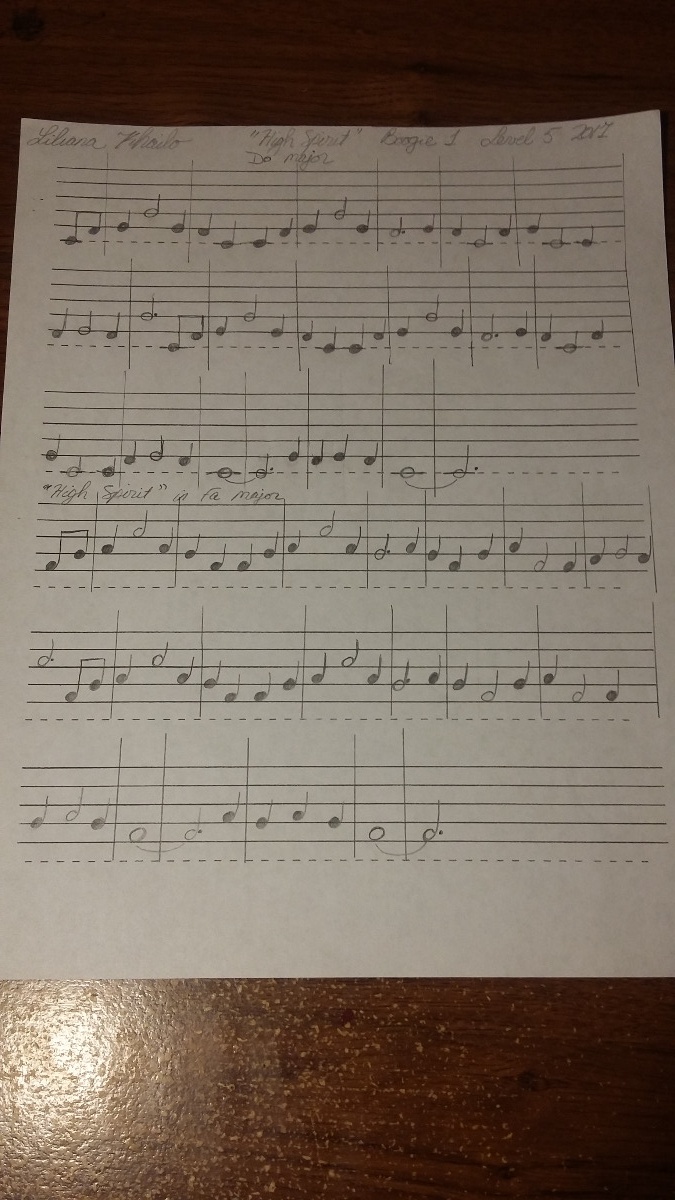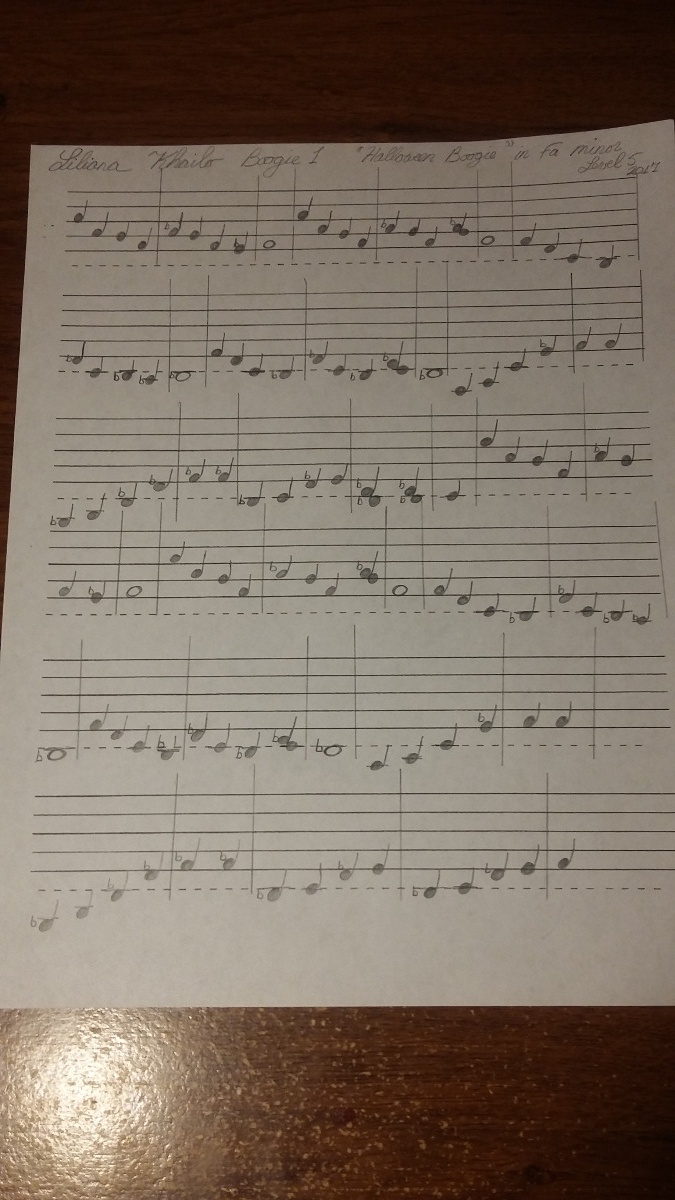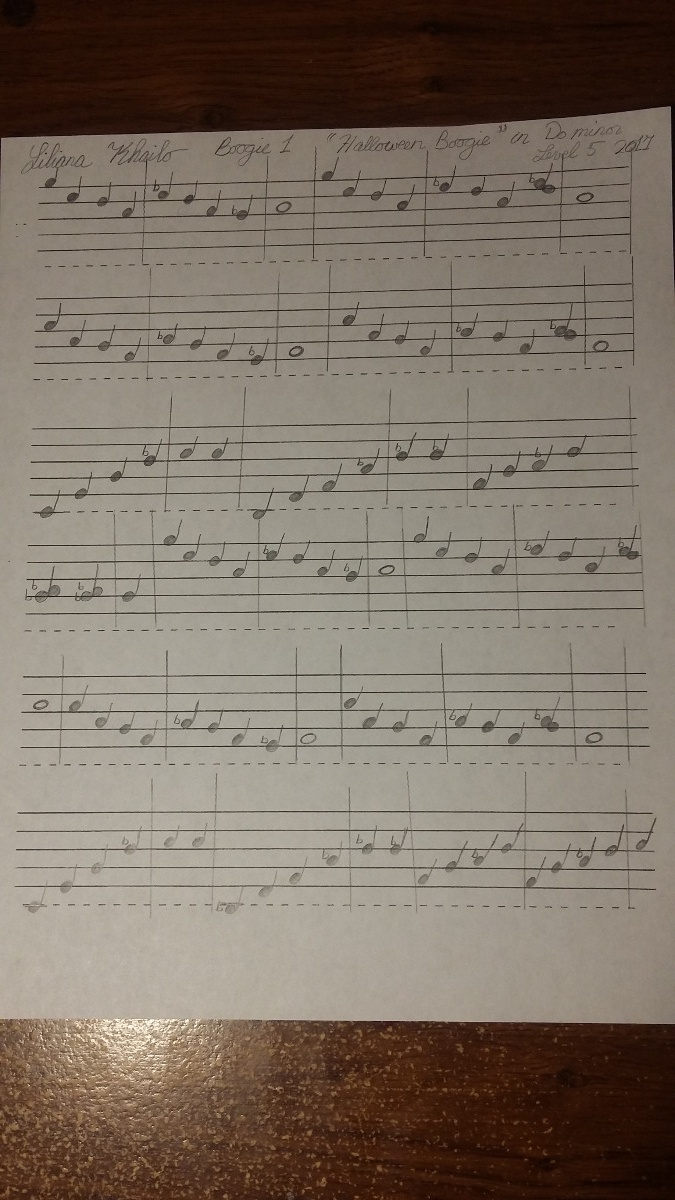Our Promotion
The countdown has ended
Save, Сэкономьте, Ahorrar
×
The 'Butterfly Ball' is Officially Over. What Next?/ "Бал Бабочек" закончен. Что дальше?/La Gala de Mariposas ha terminado oficialmente. ¿Qué sigue? (12 Feb 2024)
Unlock Your 'Butterfly Ball' Benefits: Certificates and Discounts Awaiting!
Откройте для себя преимущества «Бала Бабочек»: начинаем производить сертификаты и назначать скидки!
¡Desbloquea tus beneficios de la Gala de Mariposas: Certificados y descuentos te esperan!
×
2017-2018
Liliana, USA
- KHAILO
-
 Topic Author
Topic Author
- Visitor
-

15 Jan 2018 16:50 - 15 Jan 2018 17:11 #28296
by KHAILO
Liliana, USA was created by KHAILO
Progress Diaries for Level 5
Music History
1. Sonata Form
The sonata form is a musical structure that has 3 main movements and was first intended for the violin but later adapted to the piano. The sonata is part of the early Classical period, which lasted from the mid-18th century to the 20th century; however, the framework of the sonata was formed by Beethoven in the Romantic era and was further developed by Strauss. Classical composers who composed sonatas include Haydn, Mozart, Beethoven, Czerny, and Schubert. In the modern era, Prokofiev and Shastakovich were great composers of sonatas.
The three main sections of a sonata are the exposition, development, and a recapitulation.
An introduction in a sonata is optional, but when it is used, it usually focuses on a dominant key. The exposition is the primary thematic material and is commonly repeated throughout the piece. After the exposition ends, the development begins on the same key the exposition ended on and continues to explore other tone varieties until it ends on the tonic key. The recapitulation is an altered repeat of the exposition and is sometimes followed by a coda, which ends on the original tonic key.
A few good examples of the sonata form are: Sonata No. 6 by Vivaldi; Sonata in F major by Haydn; Moonlight Sonata by Beethoven; Piano Concerto Op. 5 by Strauss; and Sonata for Cello and Piano by Shastakovich.
2. History of Orchestra Creation
The orchestra is a combination of string, brass, wind-wood, and percussion instruments to form harmonious music. Each instrument is given a written part to play in a section of a piece. The orchestra has been around since the Renaissance, the Baroque period of music. The first orchestra was created by Claudio Monteverdi. Orchestration was further developed by Bach, Haydn, and Beethoven. In the 19th century, composers themselves became orchestra conductors; the greatest of which were Wagner, Berlioz, and Strauss.
A conductor's job is to guide the entire orchestra and instruct performers. He uses his baton and a variety of hand gestures to signal the correct tempo, entries, and phrasing of the music.
Some of the best examples of orchestra music are: Haydn's Surprise Symphony; Beethoven's Symphony No. 5; Monteverdi's Lamento di Arianna; Bach's Orchestral Suites No. 1- No. 4; and Strauss' Blue Danube Waltz.
3. History of Piano Creation
We are all familiar with the piano, but this unique instrument is a relatively new invention when compared to other instruments. The modern piano was created by Bartolomeo Cristofori of Padua in 1698 or 1700, an expert harpsichord maker. It was later named the pianoforte in 1732. Opposite to today's piano, this first piano had black natural keys and white accidentals. Later on, a man named Sebastian LeBlanc suggested for the colors of the keys to be switched to how we see it today: white natural keys and black accidentals.
The predecessors of the piano were the clavichord and harpsichord. These keyboard instruments looked very similar to the piano but sounded quite different. The innovation of the piano was that the hammer hit the key and then immediately jumped back into place when the key was released. This also allowed more control over the dynamics of the piano notes.
Interestingly, when Bach first tried playing the prototype piano, he didn't like the sound. He even criticized the invention. However, his critique was helpful in the improvement of the piano. When he later tried a new version of the piano, he was impressed and approved it. He even played a theme on it for a Prussian king. Afterwards, the piano became so popular that it was the height of fashion for nobles to have a piano in their homes from the mid to late 18th century.
4. Romantic Period in music.
The Romantic period is part of the era of Western Classical music that began in the late 18th or early 19th century. It is part of the Romanticism movement, which was a reaction to the Industrial Revolution. This movement was especially strong in Germany. Early Romantic composers were Beethoven, Schubert, Schumann, Chopin, Mendelssohn, Bellini, and Berlioz. Later Romantic composers included Strauss, Brahms, Liszt, Tchaikovsky, Verdi, Wagner, Grieg, and Puccini.
Romantic music was expressive and emotional and indicated a mystical fascination with the past. Its rich harmonies and lyrical melodies along with the expanded use of orchestration made it a very distinctive period in music history. This period also introduced newly invented instruments into the orchestra. The bass tuba was invented in 1835 and the saxophone was invented in 1846. Besides these new instruments, commonly used instruments in the Romantic era were harps, cymbals, xylophones, bassoons, oboes, flutes and clarinets. Pieces that exemplify the Romantic era are: Strauss' On the Beautiful Blue Danube, Mendelssohn's Wedding March; Rossini's William Tell Overture; Chopin's Fantasie-Impromptu; and Tchaikovsky's Swan Lake Suite.
5. Schubert: Biography and main works
Schubert was an Austrian composer born near Vienna in January of 1797. Taught by Antonio Salieri, his first musical accomplishment was a masterpiece he wrote at the age of 17. He later dropped out of law school to be a composer after being deeply inspired by Mozart. He became a very famous late Classical and early Romantic composer. Although he struggled through poverty and was called "Little Mushroom" by his friends for his short height of only 5 1", he was a genius when it came to music. Sadly, Schubert died before his 32nd birthday from syphilis in 1828. Nevertheless, he had a very productive short life and composed over 600 pieces, 20 piano sonatas, and 50 choral works. Mendelssohn, Schumann, Liszt, and Brahms revered his work greatly and inspired by his talent. Schubert's most famous work is Ave Maria; Die Winterreise, Symphony No. 5, Tamtum Ergo in E flat, and Symphony No. 8 in B minor (unfinished) are among his other most famous compositions.
6. Schumann: Biography and main works
Robert Schumann (1810-1856) was a German composer and influential music critic of the Romantic era. Similar to Schubert, Schumann left law school to pursue a career in music. He was a virtuoso pianist who began composing at the age of 7. His teacher, Friedrich Wiech, encouraged Schumann and believed he could become the finest pianist in Europe. Unfortunately, Schumann was forced to abandon this dream due to a hand injury; this is why he turned to composing. In the beginning, he only composed for solo piano, but later, he also composed for orchestras. His work mainly consisted of lieders, orchestras, chorals and chamber works, but also created 4 symphonies and 1 opera. In 1840 alone, he wrote at least 138 pieces. His most famous pieces were Carnaval, Kriezleriana, Fantasie in C and Symphonic Studies.
In 1840, Schumann married his teacher's daughter, Clara, with whom he traveled Europe for concert tours. Despite his musical genius, Schumann suffered from depression. Initial signs of his mental disorder appeared in 1833, and in 1854, he attempted suicide. He admitted himself to a mental asylum, where he stayed until his death. His severe madness included hearing musical hallucinations and a constant A note that annoyed him. His insanity was the cause of his death in that same year. Nevertheless, Schumann made an enormous contribution to the Romantic era and influenced Felix Mendelssohn and Johannes Brahms.
7. Frederic Chopin
Chopin (1810-1849) was a Polish composer and virtuoso pianist of the Romantic era. Like many other significant composers, Chopin was a child prodigy and was inspired by Mozart and Bach. Born and raised in Poland, he moved to Paris at the age of 21 and acquired French citizenship in 1835. There he made a living off of selling his compositions and giving piano lessons, and he proved to be a very successful and popular piano teacher. He invented the concept of the instrumental ballad and is highly associated with nationalism in his music. Although he composed over 230 works for solo piano, Chopin only performed about 30 piano concerts during his life. He was a fan of Robert Schumann and corresponded with Felix Mendelssohn in 1834. Some of his best works include: Nocturne in B-flat minor, Op. 9 No. 1, Minute Waltz, Scherzo No. 2 Op. 31. and Grande Valse Brilliante Op. 18.
8. Edvard Grieg
Edvard Grieg (1843-1907) was a Norwegian composer and pianist known for his nationalistic music. His music was so influential in his country that several cultural entities are named after him. These include the Grieg Hall concert building, Edvard Grieg Kor (choir), Quality Hotel Edvard Grieg, and Edvard Grieg Museum. Grieg was taught to play the piano from the age of 6 by his mother. At 15, he attended the Leipzig Conservatory and in 1861, he performed his very first concert. In 1868, he met Franz Liszt and corresponded with him and in 1888, he met Tchaikovsky in Leipzip, from whom he received praise for his work. Grieg was so accomplished that he received 2 honorary doctorates from Cambridge University in 1894 and Oxford University in 1906. Only a year after receiving his doctorate at Oxford, he died at the age of 64 from heart failure, having been ill most of his life. At his request, his friend Rikard Nordaak played his very own Funeral March at his funeral. Chopin's most famous works remain to be In the Hall of Mountain King and Piano Concerto in A minor.
9. Hector Berlioz
The French Romantic composer Hector Berlioz was born in 1803 and died in 1869. Berlioz was unique from other composers in that he was a self-taught musician. He had no formal training. Instead, he learned everything he knew about music from textbooks. He started studying at the age of 12 and learned how to play the guitar, flute, and flageolet. Although he had wanted to learn piano, Berlioz never did due to his father's discouragement. His parents disapproved of his musical endeavors. Nevertheless, Berlioz went against his parent's wishes and dropped out of the study of medicine in 1824 to pursue his musical career. In 1826, he began attending the Paris Conservatoire to study composition after being inspired by Beethoven's compositions.
During his tours, Berlioz met fellow composers Mendelssohn, Schumann, Wagner, and others. He became close friends with Franz Liszt, who later transcribed Symphonie Fantastique for the piano. Other famous pieces Berlioz composed were Harold en Italie, Romeo et Juliette and his Requiem.
10. Richard Wagner
Another notable German composer of the Romantic era was Richard Wagner (1813-1883). He was also a theater director, conductor, and polemicist. Wagner was known for his operas, or "music dramas" as he called it and owned his own opera house. His controversial writings on music, drama and politics caused him to be politically exiled from Germany during his last years. Wagner's love of theater was influenced by his stepfather Geyer, who allowed him to take part in some performances at his theater. In this environment, Wagner was strongly influenced by Shakespeare and Goethe. In 1820, Wagner began taking piano lessons, but preferred to play by ear. He was determined to set plays to music, so he began taking music lessons in 1827. In 1821, he enrolled in the Leipzig University and studied composition under his teacher Thomaskantor Theodor Weinlig. Weinlig was so impressed by Wagner's musical capabilities that he taught him for free. Wagner's training was successful, and in 1833 at the age of 20, he composed his first opera, Die Feen ( the Fairies). His career took off and he continued to continued to produce works for Opera houses. His best works include Parsifal and Symphony in C major. Among others, Wagnar influenced Gustav Mahler with his magnificent work. His work also influenced literature, philosophy, the cinema, and philosophy. In 1883, Wagner died at the age of 69 from a heart attack.
11. Giuseppe Verdi
Verdi (1813-1901) was an Italian opera composer and one of the most significant opera composers in history. In his early operas, he expressed nationalism favoring the unification of Italy- Va, pensiero from Nabucco (1842) is the best example. At the age of 8, being very musically talented, Verdi became a paid organist in a church. He later became a student of a music school at age 12. Between 13 to 18 years of age, he wrote a variety of pieces, including concertos, serenades, cantatos, and marches. He performed his first concert at the age of 13 as a replacement, gaining him much local recognition. In 1830, he officially became the leader of the Philharmonic Society; there he taught the members music and conducted the orchestra. Verdi composed his first opera Rocester (later renamed Oberto) in 1834-1842 and it proved to be a success. However, his next opera was a complete failure due to his depression from losing his wife and 2 infant children. This difficult time in Verdi's life made him believe that he would never compose again, but after Merelli's persuasion, he made an attempt and composed Nabacco, a lasting success. After that, Verdi worked very hard and composed 20 operas between 1842-1849, the most famous of which was I Lombardi all prima. Between 1849 and 1853, Verdi gained much fame. He was invited to and performed La Forza in St. Petersburg, Russia and Aida in Cairo, Egypt between 1860 to 1887. His greatest successes were his Requiem, Otello, and Falstaff. In 1901, a stroke caused his death at the age of 87. During his lifetime, Verdi performed 57 times. He gained very much respect and admiration for his musical contributions, and 300,00 attended his funeral to honor his life's work.
12. Gioachino Rossini
Yet another significant Italian composer was Gioachino Rossini (1792-1868). His revered work and extraordinary talent earned him the title "the Italian Mozart." His father having been a horn player and his mother having been a singer, Rossini was very much musically inclined. As a boy, he had 3 years of instruction in playing the harpsichord and learned to play the cello and the horn; at age 10, he learned to sight read and play the piano and sang solos at his church. He first began to compose at age 12 and completed his first composition, Demetrio e Polibio, at age 13 or 14 and premiered it at age 20. However, his first performance was at age 18 of La CamBiale de Matrimonio. By 20 years of age, Rossini had gained international fame for his operas and by 21, he was an idol of Italian Opera. The Barber of Seville, 1816, became his most famous work. In 1823, he moved to Paris and also gained renown there. Overall, he composed 39 significant operas during his lifetime. In 1829, he retired from theater due to illness and then resorted to composing salon music, piano pieces and chamber ensembles when his health improved. Several contemporary composers praised Rossini's talent, such as Liszt, Saint-Saens and others; he also had the opportunity to meet the 51 year old Beethoven and received much praise and encouragement from him as well. When he was 76, Rossini passed away from pneumonia in Paris; in 1887, his remains were moved to Florence, Italy. He went down in history as the most famous opera composer in history. Later on, Guiseppe Verdi and 12 other composers wrote the Requiem for Rossini in his honor.
Music History
1. Sonata Form
The sonata form is a musical structure that has 3 main movements and was first intended for the violin but later adapted to the piano. The sonata is part of the early Classical period, which lasted from the mid-18th century to the 20th century; however, the framework of the sonata was formed by Beethoven in the Romantic era and was further developed by Strauss. Classical composers who composed sonatas include Haydn, Mozart, Beethoven, Czerny, and Schubert. In the modern era, Prokofiev and Shastakovich were great composers of sonatas.
The three main sections of a sonata are the exposition, development, and a recapitulation.
An introduction in a sonata is optional, but when it is used, it usually focuses on a dominant key. The exposition is the primary thematic material and is commonly repeated throughout the piece. After the exposition ends, the development begins on the same key the exposition ended on and continues to explore other tone varieties until it ends on the tonic key. The recapitulation is an altered repeat of the exposition and is sometimes followed by a coda, which ends on the original tonic key.
A few good examples of the sonata form are: Sonata No. 6 by Vivaldi; Sonata in F major by Haydn; Moonlight Sonata by Beethoven; Piano Concerto Op. 5 by Strauss; and Sonata for Cello and Piano by Shastakovich.
2. History of Orchestra Creation
The orchestra is a combination of string, brass, wind-wood, and percussion instruments to form harmonious music. Each instrument is given a written part to play in a section of a piece. The orchestra has been around since the Renaissance, the Baroque period of music. The first orchestra was created by Claudio Monteverdi. Orchestration was further developed by Bach, Haydn, and Beethoven. In the 19th century, composers themselves became orchestra conductors; the greatest of which were Wagner, Berlioz, and Strauss.
A conductor's job is to guide the entire orchestra and instruct performers. He uses his baton and a variety of hand gestures to signal the correct tempo, entries, and phrasing of the music.
Some of the best examples of orchestra music are: Haydn's Surprise Symphony; Beethoven's Symphony No. 5; Monteverdi's Lamento di Arianna; Bach's Orchestral Suites No. 1- No. 4; and Strauss' Blue Danube Waltz.
3. History of Piano Creation
We are all familiar with the piano, but this unique instrument is a relatively new invention when compared to other instruments. The modern piano was created by Bartolomeo Cristofori of Padua in 1698 or 1700, an expert harpsichord maker. It was later named the pianoforte in 1732. Opposite to today's piano, this first piano had black natural keys and white accidentals. Later on, a man named Sebastian LeBlanc suggested for the colors of the keys to be switched to how we see it today: white natural keys and black accidentals.
The predecessors of the piano were the clavichord and harpsichord. These keyboard instruments looked very similar to the piano but sounded quite different. The innovation of the piano was that the hammer hit the key and then immediately jumped back into place when the key was released. This also allowed more control over the dynamics of the piano notes.
Interestingly, when Bach first tried playing the prototype piano, he didn't like the sound. He even criticized the invention. However, his critique was helpful in the improvement of the piano. When he later tried a new version of the piano, he was impressed and approved it. He even played a theme on it for a Prussian king. Afterwards, the piano became so popular that it was the height of fashion for nobles to have a piano in their homes from the mid to late 18th century.
4. Romantic Period in music.
The Romantic period is part of the era of Western Classical music that began in the late 18th or early 19th century. It is part of the Romanticism movement, which was a reaction to the Industrial Revolution. This movement was especially strong in Germany. Early Romantic composers were Beethoven, Schubert, Schumann, Chopin, Mendelssohn, Bellini, and Berlioz. Later Romantic composers included Strauss, Brahms, Liszt, Tchaikovsky, Verdi, Wagner, Grieg, and Puccini.
Romantic music was expressive and emotional and indicated a mystical fascination with the past. Its rich harmonies and lyrical melodies along with the expanded use of orchestration made it a very distinctive period in music history. This period also introduced newly invented instruments into the orchestra. The bass tuba was invented in 1835 and the saxophone was invented in 1846. Besides these new instruments, commonly used instruments in the Romantic era were harps, cymbals, xylophones, bassoons, oboes, flutes and clarinets. Pieces that exemplify the Romantic era are: Strauss' On the Beautiful Blue Danube, Mendelssohn's Wedding March; Rossini's William Tell Overture; Chopin's Fantasie-Impromptu; and Tchaikovsky's Swan Lake Suite.
5. Schubert: Biography and main works
Schubert was an Austrian composer born near Vienna in January of 1797. Taught by Antonio Salieri, his first musical accomplishment was a masterpiece he wrote at the age of 17. He later dropped out of law school to be a composer after being deeply inspired by Mozart. He became a very famous late Classical and early Romantic composer. Although he struggled through poverty and was called "Little Mushroom" by his friends for his short height of only 5 1", he was a genius when it came to music. Sadly, Schubert died before his 32nd birthday from syphilis in 1828. Nevertheless, he had a very productive short life and composed over 600 pieces, 20 piano sonatas, and 50 choral works. Mendelssohn, Schumann, Liszt, and Brahms revered his work greatly and inspired by his talent. Schubert's most famous work is Ave Maria; Die Winterreise, Symphony No. 5, Tamtum Ergo in E flat, and Symphony No. 8 in B minor (unfinished) are among his other most famous compositions.
6. Schumann: Biography and main works
Robert Schumann (1810-1856) was a German composer and influential music critic of the Romantic era. Similar to Schubert, Schumann left law school to pursue a career in music. He was a virtuoso pianist who began composing at the age of 7. His teacher, Friedrich Wiech, encouraged Schumann and believed he could become the finest pianist in Europe. Unfortunately, Schumann was forced to abandon this dream due to a hand injury; this is why he turned to composing. In the beginning, he only composed for solo piano, but later, he also composed for orchestras. His work mainly consisted of lieders, orchestras, chorals and chamber works, but also created 4 symphonies and 1 opera. In 1840 alone, he wrote at least 138 pieces. His most famous pieces were Carnaval, Kriezleriana, Fantasie in C and Symphonic Studies.
In 1840, Schumann married his teacher's daughter, Clara, with whom he traveled Europe for concert tours. Despite his musical genius, Schumann suffered from depression. Initial signs of his mental disorder appeared in 1833, and in 1854, he attempted suicide. He admitted himself to a mental asylum, where he stayed until his death. His severe madness included hearing musical hallucinations and a constant A note that annoyed him. His insanity was the cause of his death in that same year. Nevertheless, Schumann made an enormous contribution to the Romantic era and influenced Felix Mendelssohn and Johannes Brahms.
7. Frederic Chopin
Chopin (1810-1849) was a Polish composer and virtuoso pianist of the Romantic era. Like many other significant composers, Chopin was a child prodigy and was inspired by Mozart and Bach. Born and raised in Poland, he moved to Paris at the age of 21 and acquired French citizenship in 1835. There he made a living off of selling his compositions and giving piano lessons, and he proved to be a very successful and popular piano teacher. He invented the concept of the instrumental ballad and is highly associated with nationalism in his music. Although he composed over 230 works for solo piano, Chopin only performed about 30 piano concerts during his life. He was a fan of Robert Schumann and corresponded with Felix Mendelssohn in 1834. Some of his best works include: Nocturne in B-flat minor, Op. 9 No. 1, Minute Waltz, Scherzo No. 2 Op. 31. and Grande Valse Brilliante Op. 18.
8. Edvard Grieg
Edvard Grieg (1843-1907) was a Norwegian composer and pianist known for his nationalistic music. His music was so influential in his country that several cultural entities are named after him. These include the Grieg Hall concert building, Edvard Grieg Kor (choir), Quality Hotel Edvard Grieg, and Edvard Grieg Museum. Grieg was taught to play the piano from the age of 6 by his mother. At 15, he attended the Leipzig Conservatory and in 1861, he performed his very first concert. In 1868, he met Franz Liszt and corresponded with him and in 1888, he met Tchaikovsky in Leipzip, from whom he received praise for his work. Grieg was so accomplished that he received 2 honorary doctorates from Cambridge University in 1894 and Oxford University in 1906. Only a year after receiving his doctorate at Oxford, he died at the age of 64 from heart failure, having been ill most of his life. At his request, his friend Rikard Nordaak played his very own Funeral March at his funeral. Chopin's most famous works remain to be In the Hall of Mountain King and Piano Concerto in A minor.
9. Hector Berlioz
The French Romantic composer Hector Berlioz was born in 1803 and died in 1869. Berlioz was unique from other composers in that he was a self-taught musician. He had no formal training. Instead, he learned everything he knew about music from textbooks. He started studying at the age of 12 and learned how to play the guitar, flute, and flageolet. Although he had wanted to learn piano, Berlioz never did due to his father's discouragement. His parents disapproved of his musical endeavors. Nevertheless, Berlioz went against his parent's wishes and dropped out of the study of medicine in 1824 to pursue his musical career. In 1826, he began attending the Paris Conservatoire to study composition after being inspired by Beethoven's compositions.
During his tours, Berlioz met fellow composers Mendelssohn, Schumann, Wagner, and others. He became close friends with Franz Liszt, who later transcribed Symphonie Fantastique for the piano. Other famous pieces Berlioz composed were Harold en Italie, Romeo et Juliette and his Requiem.
10. Richard Wagner
Another notable German composer of the Romantic era was Richard Wagner (1813-1883). He was also a theater director, conductor, and polemicist. Wagner was known for his operas, or "music dramas" as he called it and owned his own opera house. His controversial writings on music, drama and politics caused him to be politically exiled from Germany during his last years. Wagner's love of theater was influenced by his stepfather Geyer, who allowed him to take part in some performances at his theater. In this environment, Wagner was strongly influenced by Shakespeare and Goethe. In 1820, Wagner began taking piano lessons, but preferred to play by ear. He was determined to set plays to music, so he began taking music lessons in 1827. In 1821, he enrolled in the Leipzig University and studied composition under his teacher Thomaskantor Theodor Weinlig. Weinlig was so impressed by Wagner's musical capabilities that he taught him for free. Wagner's training was successful, and in 1833 at the age of 20, he composed his first opera, Die Feen ( the Fairies). His career took off and he continued to continued to produce works for Opera houses. His best works include Parsifal and Symphony in C major. Among others, Wagnar influenced Gustav Mahler with his magnificent work. His work also influenced literature, philosophy, the cinema, and philosophy. In 1883, Wagner died at the age of 69 from a heart attack.
11. Giuseppe Verdi
Verdi (1813-1901) was an Italian opera composer and one of the most significant opera composers in history. In his early operas, he expressed nationalism favoring the unification of Italy- Va, pensiero from Nabucco (1842) is the best example. At the age of 8, being very musically talented, Verdi became a paid organist in a church. He later became a student of a music school at age 12. Between 13 to 18 years of age, he wrote a variety of pieces, including concertos, serenades, cantatos, and marches. He performed his first concert at the age of 13 as a replacement, gaining him much local recognition. In 1830, he officially became the leader of the Philharmonic Society; there he taught the members music and conducted the orchestra. Verdi composed his first opera Rocester (later renamed Oberto) in 1834-1842 and it proved to be a success. However, his next opera was a complete failure due to his depression from losing his wife and 2 infant children. This difficult time in Verdi's life made him believe that he would never compose again, but after Merelli's persuasion, he made an attempt and composed Nabacco, a lasting success. After that, Verdi worked very hard and composed 20 operas between 1842-1849, the most famous of which was I Lombardi all prima. Between 1849 and 1853, Verdi gained much fame. He was invited to and performed La Forza in St. Petersburg, Russia and Aida in Cairo, Egypt between 1860 to 1887. His greatest successes were his Requiem, Otello, and Falstaff. In 1901, a stroke caused his death at the age of 87. During his lifetime, Verdi performed 57 times. He gained very much respect and admiration for his musical contributions, and 300,00 attended his funeral to honor his life's work.
12. Gioachino Rossini
Yet another significant Italian composer was Gioachino Rossini (1792-1868). His revered work and extraordinary talent earned him the title "the Italian Mozart." His father having been a horn player and his mother having been a singer, Rossini was very much musically inclined. As a boy, he had 3 years of instruction in playing the harpsichord and learned to play the cello and the horn; at age 10, he learned to sight read and play the piano and sang solos at his church. He first began to compose at age 12 and completed his first composition, Demetrio e Polibio, at age 13 or 14 and premiered it at age 20. However, his first performance was at age 18 of La CamBiale de Matrimonio. By 20 years of age, Rossini had gained international fame for his operas and by 21, he was an idol of Italian Opera. The Barber of Seville, 1816, became his most famous work. In 1823, he moved to Paris and also gained renown there. Overall, he composed 39 significant operas during his lifetime. In 1829, he retired from theater due to illness and then resorted to composing salon music, piano pieces and chamber ensembles when his health improved. Several contemporary composers praised Rossini's talent, such as Liszt, Saint-Saens and others; he also had the opportunity to meet the 51 year old Beethoven and received much praise and encouragement from him as well. When he was 76, Rossini passed away from pneumonia in Paris; in 1887, his remains were moved to Florence, Italy. He went down in history as the most famous opera composer in history. Later on, Guiseppe Verdi and 12 other composers wrote the Requiem for Rossini in his honor.
Last edit: 15 Jan 2018 17:11 by KHAILO.
Please Log in or Create an account to join the conversation.
- KHAILO
-
 Topic Author
Topic Author
- Visitor
-

15 Jan 2018 17:15 #28297
by KHAILO
Replied by KHAILO on topic Liliana, USA
Please Log in or Create an account to join the conversation.
- KHAILO
-
 Topic Author
Topic Author
- Visitor
-

15 Jan 2018 17:17 #28298
by KHAILO
Replied by KHAILO on topic Liliana, USA
Please Log in or Create an account to join the conversation.
- KHAILO
-
 Topic Author
Topic Author
- Visitor
-

15 Jan 2018 17:19 #28299
by KHAILO
Replied by KHAILO on topic Liliana, USA
Please Log in or Create an account to join the conversation.
- KHAILO
-
 Topic Author
Topic Author
- Visitor
-

15 Jan 2018 17:21 #28300
by KHAILO
Replied by KHAILO on topic Liliana, USA
Please Log in or Create an account to join the conversation.
- KHAILO
-
 Topic Author
Topic Author
- Visitor
-

15 Jan 2018 17:22 #28301
by KHAILO
Replied by KHAILO on topic Liliana, USA
Please Log in or Create an account to join the conversation.
Time to create page: 0.092 seconds


